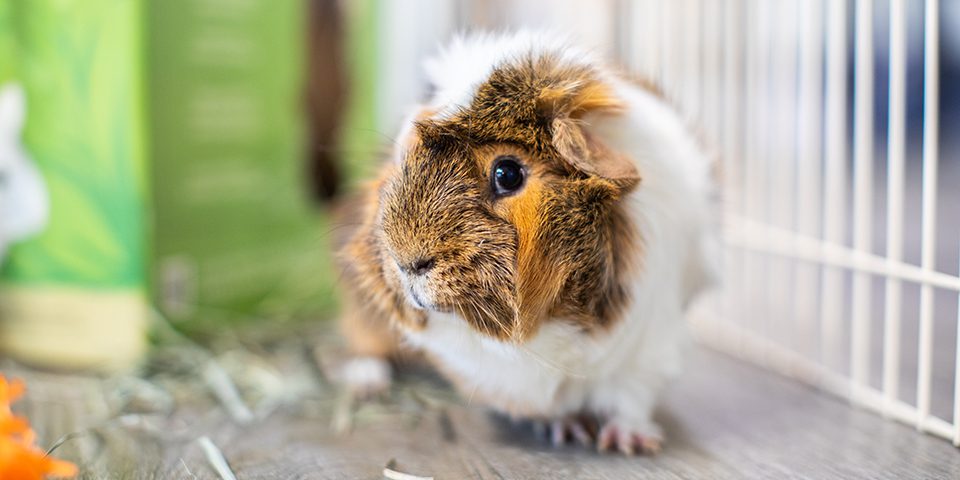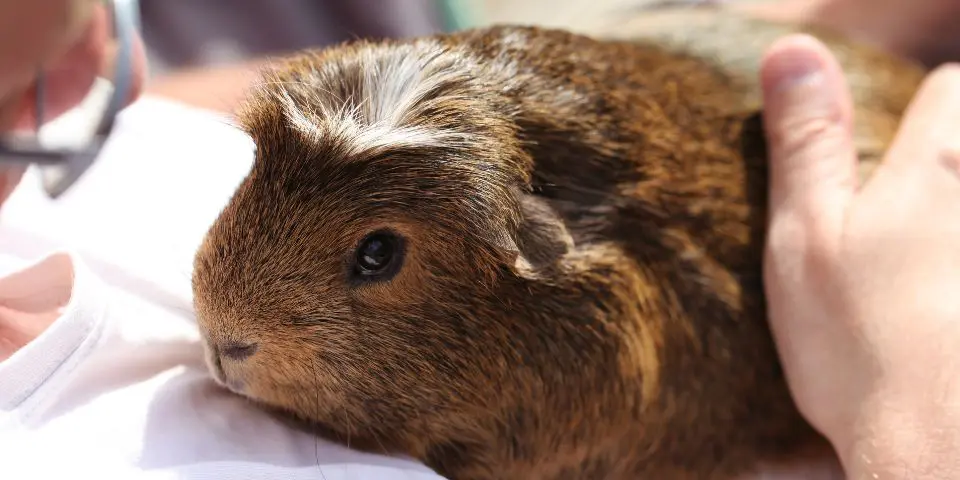Author: Kellie Hayden
Updated: August 12, 2024
Depending on a guinea pig’s breed, one of the less fun tasks of guinea pig care involves caring for your pet’s skin and coat. What some new guinea pig pet parents might not consider, however, is that a guinea pig’s grease gland requires additional care.
In this blog post, we’ll cover one of the less glamorous, yet essential, tasks of keeping your guinea pig clean: cleaning their grease gland.
What is a Guinea Pig Grease Gland?
Guinea pigs use their grease gland to scent mark their territory. It is located at the end of their spine on their backside, about where a tail would be if they had one. This gland secretes a thick, oily substance which turns into a gum-like consistency as it dries. The secretions tend to dry on the fur and skin surrounding the gland.
If not properly cared for, the grease gland can cause matting on the fur of a guinea pig’s behind; this matted, greasy fur will collect dead skin, hay pieces, and other unhygienic debris. This can understandably become very uncomfortable for your little one! Cleaning their grease gland, if done properly, can help relieve the skin irritation and tension that occurs when fur is matted, and can also help prevent potential infections.

Does My Female Guinea Pig Have a Grease Gland?
While boars (males) may have more active grease glands and therefore may need to be cleaned more often, female guinea pigs also have grease glands. You might not need to clean a female guinea pig’s grease gland as much as you would with a male, but this is not always the case. Grease gland production is a hormonally-driven process. If a female is intact or particularly dominant, or if there are intact males nearby, a female might have a more active grease gland.
How Often Should I Clean My Guinea Pig’s Grease Gland?
This answer really depends on how active your pet’s grease gland is, and there isn’t a set schedule in which you should clean a guinea pig’s grease gland. Pet parents with boars will likely need to clean their guinea pig’s grease gland more frequently than sows, but every pet is unique. Regardless of whether your pet is male or female, check your guinea pig’s grease gland once a month to see how much gummed-up material is present.
List of Supplies For Cleaning Your Guinea Pig’s Grease Gland
- At the time of this writing, there is not a product specifically made for the grease gland cleaning process. The safest methods we’d recommend are to use either 1) coconut oil or 2) diluted Dawn dish soap.
- A bottle that has been thoroughly cleaned of any products, if using the Dawn method
- A pair of non-latex gloves (if you are easily grossed out)
- Your pet’s favorite healthy treats, herbs, or greens. Do not use a treat that can cause GI upset if eaten in large quantities.
- Guinea pig-safe shampoo, if using the coconut oil method
- 3 dry towels (1 for grease gland cleaning, 1 to dry your guinea pig post-bath, and 1 for your guinea pig to rest in post-bath)
- A loaf pan, casserole dish, or some kind of flat container that won’t tip over easily
- Cotton swabs, if you don’t want to use your fingertips
- A gentle comb if your guinea pig is a long-haired breed
- A second person who can keep your pet distracted is very helpful, especially if this is the first time you’ve cleaned a grease gland
A Note on Using the Dawn Method
Dawn dish soap is very good at cutting grease, but using Dawn at its full concentration on your guinea pig’s grease gland can unintentionally strip the healthy, necessary oils on their fur and skin in this area. This will create problems for your pet, such as dry, flaky, and irritated skin.
Diluting this soap into a soap-and-water solution is necessary. Start with your squeaky-clean bottle. Measure out the Dawn and the water; your solution should consist of ¼ Dawn and ¾ water, so using ¼ cup and ¾ cup respectively will give you a lot of diluted Dawn to use for future grease gland cleanings.
Once the proper amount of each ingredient has been added to the bottle, close the bottle and shake it well to mix.

Steps For Cleaning Your Guinea Pig’s Grease Gland
Have your Dawn solution or coconut oil ready, as well as your pet’s favorite treats.
1. Collect your guinea pig from their enclosure and use the first towel as a lap pad to place your guinea pig on your lap.
2. With your pet facing away from you and sufficiently distracted with food, apply your coconut oil or diluted Dawn to the gunked-up area around their grease gland.
3. Gently work the product in with your fingertips without excessively pulling at their fur. Your pet might find this unpleasant and may vocally protest, but their favorite food usually keeps them from turning around or wiggling away.
4. Let the product sit on the “gunky” area to do its thing for a minute, making sure that your pet doesn’t turn around to groom themselves.
5. After a minute, use your fingers (or a cotton swab) to gently rub the gooey grease gland. The grease may dissolve entirely, or you might find that the clumps are breaking up, making the pieces of debris easier to remove.
The grease gland area is sensitive, so do not pull at your pet’s fur. In long-haired breeds, you might need to gently comb debris out of your pet’s fur or trim it away, rather than removing it by hand or with a cotton swab.
Before Bathing: a Note on Guinea Pig Baths
- Generally speaking, guinea pigs are clean animals that do not need to be bathed often. The only times when they need baths can include during grease gland clean-up, and when they have soiled themselves and feces or urine is coating their fur.
- When a guinea pig truly needs a bath, small amounts of non-running water in a contained setting will greatly reduce the fear factor for your little one whenever bath time rolls around. Because of this, we recommend using a clean casserole dish or loaf pan as a mini bathtub for your guinea pig if you ever need to bathe them. Simply fill the dish or pan with an inch of warm water and set it in the middle of your human bathtub. Using a hand towel and the bottom of the dish will also provide a non-slip bottom for your guinea pig to feel more secure.
- We do not recommend filling a human-sized bathtub or hold your pet under the sink faucet to bathe your guinea pig. Most guinea pigs do not like water, so the less water that is present, the better. Regardless of how many viral videos insist that this species loves to swim, most guinea pigs find that being submerged in water to any extent is a frightening, even traumatic, experience.
- Our recommended method also ensures that the chances of your pet accidentally breathing in water if they wiggle out of your grip is kept to a minimum. If your guinea pig cannot solidly stand on all four legs or needs to lift their head up to stay above water, this water is far too deep.

How To Bathe Your Guinea Pig After Grease Gland Cleaning
Once all the gunk and debris is gone, the degreaser (the dish soap or coconut oil) you used needs to be rinsed away! Have your loaf pan or casserole dish ready with 1 inch of comfortably warm water.
1. Place your guinea pig in the dish so they are standing on their hind legs while you securely restrain their front side to prevent them from jumping or bolting.
2. Use your free hand to rinse off their grease gland with water in the dish. If you used coconut oil, a small amount of guinea pig-safe shampoo may be needed to wash away all of the oil.
3. Once all the soap or oil is gone, remove your pet promptly and wrap them in a towel to stay warm. Your pet will likely be upset at this point! Plan for another treat offering as you open the towel and begin to pat dry whatever water you can from their coat.
4. After excess water is patted away, your pet can go back into their enclosure. Once they’re home, they will shake and groom themselves to get dry faster. Because high temperatures can lead to heat stroke, we do not recommend using a hair dryer on your guinea pig.
5. Giving your guinea pig a towel in their enclosure to snuggle up in can help absorb more water from their fur. Just make sure to remove it and check that their bedding is not excessively wet (bedding may need to be spot cleaned or replaced if it is damp).
Pet parenthood isn’t always pretty, and sometimes it can be a downright thankless job—grease gland cleaning is often a reminder of this fact. But regardless of how cross your pet may be in the short term, making sure they are clean and comfortable will go a long way to giving your pet a long, happy life.

